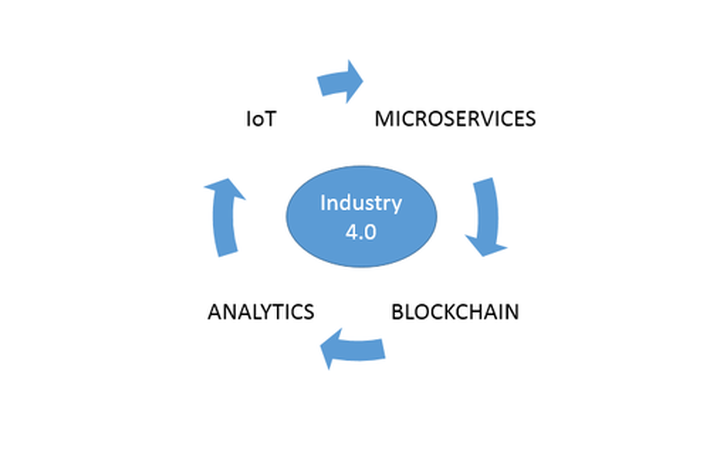
Published on 12/19/2016 | Use Cases
The introduction of new technologies in manufacturing is ushering in a fourth Industrial Revolution; Industry 4.0. This article focuses on taking the first FOUR steps to realize the vision and benefits of smarter manufacturing - Industry 4.0
In the past, all company data was locked within the enterprise. Any interaction with that data was through company portal, EDIs, email or phone. Availability of this data as service to authenticated business partners can provide great value.
Big financial institutions have already started opening up their backend systems as microservices to other parties, example https://www.finextra.com/newsarticle/29748/citi-unveils-global-api-developer-hub
For industrial companies, there is huge opportunity in exposing microservices to let developers create new innovative offerings; thereby improve supply chain efficiency and customer experience for example
Microservice for document visibility – logistics, inventory, production, invoice document microservice can provide visibility on status and reduce supply chain efficiencies across customer, vendors.
Microservice for batch quality data can reduce the duplicate quality checks in downstream value chain.
Microservice for sales, forecasting, planning – can provide customers with tight supply chain integration.
One way to expose your backend ERP services is by using the API connect service on IBM Bluemix https://console.ng.bluemix.net/catalog/services/api-connect/
Blockchain in simplistic terms refers to distributed database that cannot be altered, is encrypted and synchronized cross different parties providing visibility. This data visibility across different parties will not only improve business processes & resource efficiencies but also enable smarter transactions between parties.
For example, some business benefit cases are listed below:
Visibility of providence, traceability, genealogy across the value chain will reduce fraud, false claims, warranty cost and provide assurance to all parties including end consumer.
True value assessment of traded goods including say used equipment’s will be possible
Smarter contracts can be easily executed between parties based on incentives, penalties; will improve the overall value chain resource & cost efficiency:- reduce inventory, provide better service levels and improve productivity.
One way to get started on your own blockchain is by hosting an instance of blockchain on IBM Bluemix https://console.ng.bluemix.net/catalog/services/blockchain
Internet of Things (IoT) broadly refers to physical objects that feature an IP address for internet connectivity, and communication between objects, devices, systems. There are many IoT technologies available today, however it is important to understand the underlying business concepts for appropriately choosing the technology.
For example, let us see business use cases and possible technologies
Information updates - For tracking physical equipment’s like fire-door, where it is only essential to know history and update maintenance logs, a simple NFC, Barcode tag with a mobile app centrally storing data, can provide visibility to multiple parties.
Tracking - If the movement of goods say for example cold food chain, does require temperature range to be maintained within certain limits, a IoT device with temperature, location sensor and connectivity can provide visibility.
Smarter equipment, devices for more personalized, additional services - Hotel television acting as a virtual hotel concierge; detergent recommendation by washing machines; service equipment contracts based on usage not time; insurance premium for car based on driving risk behavior; predict equipment failure; advice service technician to bring the right parts for repair; improve safety by monitoring health condition of workers etc
Smarter equipment for new business models - selling equipment on uptime, throughput, consumption or use based on continuous device sensor feedback and real time analytics.
One way to get started with IoT is by creating your own service for Watson IoT platform on IBM Bluemix https://console.ng.bluemix.net/catalog/services/internet-of-things-platform/
Traditionally, we have focused analytics to answer questions like “Why did it happen?” or “What is happening?”. However today with availability of data from multiple sources (transactions, sensors, photos, log data, social media, weather etc) and advanced analytics tools we can ask the question “What could happen?” or “What action should I take?” or “What did I learn?”.
Practical uses cases for analytics focus on a very specific problem and analyze all underlying factors for a desired outcome. For example an analytics model (or CPS) for a motor will be able to detect any anomaly of operation and predict failure of the motor. It will also be able to govern the operation of motor and provide any notifications to operator in real time.
One way to get started with Analytics is to leverage IBM Data Science Platform to build analytics model using historical data http://datascience.ibm.com/ and use IBM Watson Machine Learning for executing the model on real time equipment data https://console.ng.bluemix.net/catalog/services/ibm-watson-machine-learning
Today we can start by implementing these FOUR practical steps in the direction of Industry 4.0 vision. In future, we can expand to fulfill the vision of Industry 4.0, ie have autonomous CPS governed by agreed KPIs across the entire value chain of business partners.
Note - Industry 4.0 Definition.
Key features of Industry 4.0 are Horizontal integration through value networks; End-to-end digital integration of engineering across the entire value chain; Vertical integration and networked manufacturing systems. At the center of, Industry 4.0 is the concept of cyber physical systems (CPS), digital representation of physical processes, which can independently exchange, respond and manage the process end to end across the value chain. For example CPS for assembly line is interacting with CPS at store to access customer demand.
This article was originally posted on LinkedIn.